
T Degree Show Catalogue 2023 MLitt Fine Art Practice MLitt Curatorial Practice (Contemporary Art) MLitt Art Writing MLIT
Degree Show
Catalogue 2023
MLitt Fine Art Practice
MLitt Curatorial Practice
(Contemporary Art)
MLitt Art Writing
 Image courtesy of Michelle Hannah from the exhibition 'Title…Pending', performance by Ellen Crofton
Image courtesy of Michelle Hannah from the exhibition 'Title…Pending', performance by Ellen Crofton
Contents
5 Introduction Professor Rebecca Fortnum, Head of School of Fine Art
9 MLitt Fine Art Practice
107 MLitt Curatorial Practice (Contemporary Art)

167 MLitt Art Writing
196 Programme Information
198 Thanks
Excerpts from the 2022/23 Friday Event series, a programme of lectures and discussions hosted by the School of Fine Art at The Glasgow School of Art, have been included in this catalogue. The transcripts feature questions posed by students to visiting artists and practitioners and give a flavour of our conversations through the year.
Image courtesy of Michelle Hannah, studio of Laura Vinas
Introduction
Psssst! I’m not sure I should say this, but the MLitt courses are something of a jewel in the School of Fine Art’s crown. Artists, curators and writers in the making, come from all around the globe, with a multitude of experience and backgrounds, spending a single year responding to Glasgow and the intellectual and professional challenges their tutors throw at them. Only fearless souls need apply!

As you will see, their ambition is evident in the focussed and committed work they produce. What extraordinary and diverse interests and skills are on show here. Our thanks are due to these powerful cultural producers for showing us all how it’s done. They now go into the world supported by their peers and bolstered by the deep ties formed here. And, to the MLitt tutors who have provided them with strong yet caring leadership in these tough times – I am sure your students will want to join me in saying - it is a privilege to work with you.
of
5
Professor Rebecca Fortnum Head
School of Fine Art
2023
Olivia Wiles, Art Writing: Boys with Books, French Street, Glasgow, March

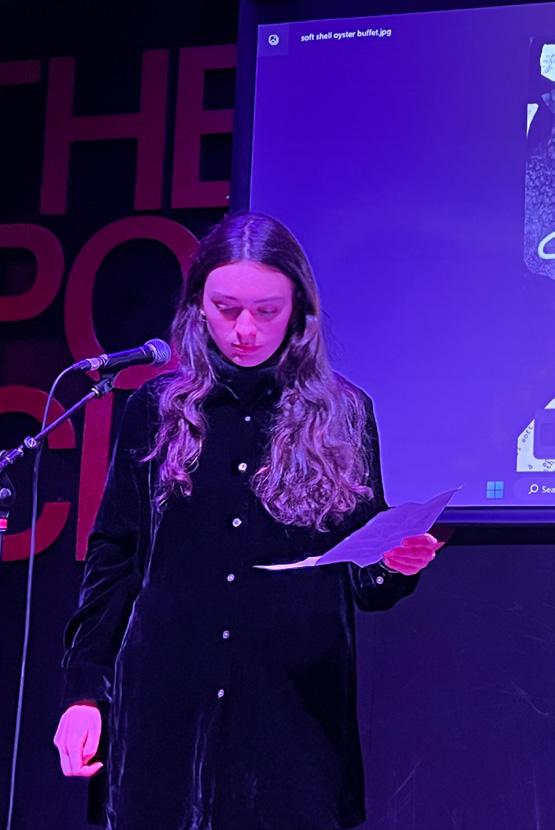
2022
Alice Hill-Woods, Art Writing: Soft Shell, The Poetry Club,
December
Image courtesy of Michelle Hannah, Studio of Iyla Shah, MLitt Fine Art Practice
MLitt Fine Art Practice


2022–2023
The 2022-23 session on the Programme has brought together a fantastic mixture of students from across the world. They have come from as diverse places as Argentina, China, South Korea, Italy, Finland, Mozambique, Saudi Arabia and Taiwan to name a few but also some from much closer to home, here in Scotland and the wider UK. An amazing group, they have worked tirelessly together for the entire year and have formed a fantastic collective of practitioners who have worked collegiately, supportively and respectfully with each other.
This mix of cultures, approaches, traditions and histories have gelled together into an amazing dynamic and the work produced for the final Exhibition in the Stow Building is testament to the individuality that we foster for each student.
multidisciplinary arena. We encourage our graduates to stay in contact, from all of the geographic locations they may return to or new destinations to unfold. The community grows each year and we are privileged to be able to be part of it.
The students have taken part in two Group exhibitions in the Barnes Building Garage space this year, one in the first Stage titled Early Days and a second show in Stage 2 titled Reposte. These were excellent opportunities to encourage the students to work quickly, attempt new things, not to be too precious, try something different if you feel the desire. These then led on to the students finding a space for themselves and arranging a superbly successful show Title…Pending, in French Street Space, (a space located in the East End of Glasgow where industrial buildings are being re-imagined and re-purposed into galleries and studio complexes, often by graduates from the School).

This opportunity tapped into the individual skillsets of the students, working together as a team to make the exhibition manifest and has undoubtedly contributed to the organisation and professionalism of the cohort and the steps they take into the future in whichever direction their careers unfold.
As the Programme nears the end of its twelfth year, it still holds the same values from its inception; to attract a diverse range of artists with a desire to embrace specialist study within a
 Mick
Mick
11 10
MLitt Fine Art Practice
McGraw Programme Leader, MLitt Fine Art Practice
Image courtesy of Michelle Hannah, performance by Daisy Qi Dai , from the exhibition 'Title... Pending'
Image courtesy of Michelle Hannah, studio of Emily Ritchie


13 12
FISH KNOW EVERYTHING Three-channel video • 200x200x120cm
Yige Bao baoyige99@outlook.com @ yige_bao8
THE SHEEP video • 50x50cmx50cm
Lorien Barker

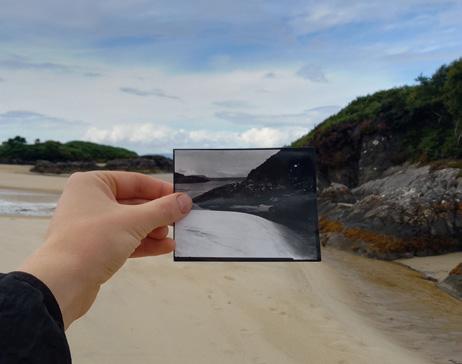
15 14
Seaweed developed 5x4" silver gelatine prints. Made onsite
Seaweed developed 5x4" silver gelatine prints. Made onsite


17 16
Bus stop Projection • 40cmx40cm
Fern projection Digital image • 40cmx40cm
susanbreckenridge201@yahoo.com @susanmlitt
Susan Breckenridge
In the visual world, our first impressions (First impressions are an automatic and unconscious psychological process are often reinforced by our second impressions (As they interact more, learn more, and observe further, their first impressions may be reinforced, modified, or even completely overturned). Thus, I tend to interpret fixed symbols in fixed ways to break down this stereotype by creating works that contrast reality with unreality, meaning with alternative meanings, initial appearances compare with revelations.
The relationship between reality and fiction in society is complex and dynamic. I regard the process of self-observation as a kind of “fiction”, while the natural elements in the painting represent the “reality” of the external world. However, the distinction between reality and fiction is becoming increasingly blurred in contemporary society. By continually critiquing the process of self-knowledge and providing a framework within which I attempt to express the complex interplay between the two through creation.
In practice, I choose natural elements to build visual confusion and a sense of connection with the real world to express how I understand the relative objectivity of the external world.

19 18
Flowing softly
Acrylic and mixed rice paper on canvas • 91.4 x 121.9cm cwen9298@gmail.com @cwen9298 @sevenwenc
Cai, (Seven) Wen
Flowing softly
It may not immediately look like it, but this installation is alive.

Entangled creatures are drawn in a sea of living pigments that have a life cycle and will fade overtime. These creatures were born through an exercise of observing different behaviours and living beings in nature, which were later entangled into a series of speculative beings.
The living sculptures, breathing throughout this space, were also born from an interweaving of different elements from nature and brought to life by the growing plants that set roots with them. Once watered, the excess water drips on to the composition on the floor and interacts with it, allowing its seeds to grow and its colours to change.
In this environment of living bodies and materials, you are invited to take a step back from your perception of individuality and to appreciate how truly entangled life is.
21 20
Alchemical Entanglements
Fabric sculpture with chia and broccoli sprouts • Detail, image taken by Rosie Hart
@2adriyana2
Adriyana 2adriyana2@gmail.com
ellencrofton.com
ellen.crofton@outlook.com
@c.ad.enc.e
counting b e e c h n u t s
‘suppose you do change your life./& the body is more than/a portion of night – sealed with bruises. Suppose you woke/& found your shadow by a black wolf’1
at night sew pockets onto your shadow and make daisy chains out of unremembered parts of you
looking on and in between,
underneath those loud paces and fallen shadows behind it all but seeing all told to fear the gentle everything.
I see you counting beechnuts behind full skies.
‘i keep on falling/in and out/ of myself/ just as i fell out of paradise’2
... and so we find ways to dance in the chaos, the uncomfortable; to celebrate or to find ecstasy in states of unknown...
If we unearth the spaces behind brown noise, between movement, motion, or the gaps underneath textures, we might be able to find a place of continuum; a space with no binaries. Perhaps the membranes within and around us allow the queering of real and imaginary realms.

23 22 in shadow she f a l ls Moving
and performance ellen crofton
image, installation,
1 Ocean Vuong, ‘Torso of Air’, in Night Sky with Exit Wounds (London: Cape Poetry, 2017), p. 53.
2 Deborah Levy, The Suburbs of Hell (London: And Other Stories, 2014)


25 24 Let me stay alone with my pink Latex, plaster • flexible Can I eat you? Digital photographic • flexible Qi Dai Qidaidaisy@qq.com @Qidai146
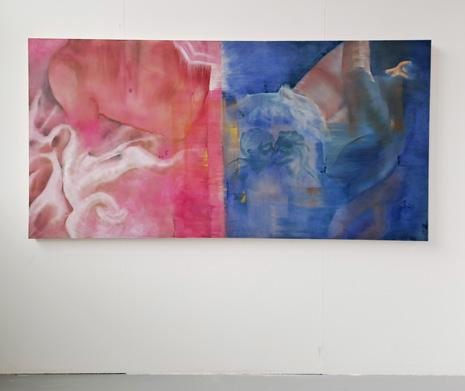

27 26
Memories of The Lover oil on canvas • 240 cm x 120 cm
Asya Dall'Agata asyadallagata.com dallagatasya@gmail.com @asyadallagata
Screenshot of The Lover, series Oil on canvas • 30 cm x 40 cm

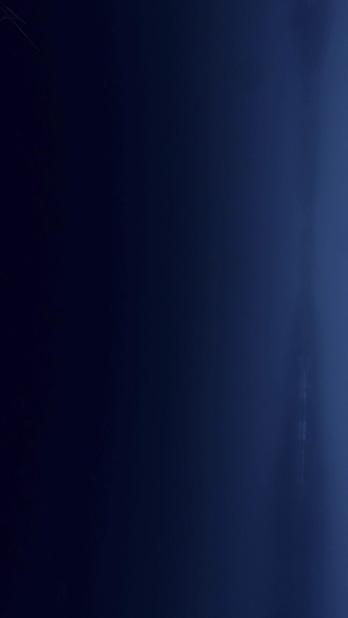
29 28 If It Was Here Digital Moving Images If It Was Here Digital Moving Images Chuan Du ivarga01.cargo.site boatie030@gmail.com @ivarga030


31 30 Screen print into newsprint Screen print onto newsprint Emma Feeney Emmajayne.artwork@gmail.com @Emmajayne.artwork


33 32 Rolling to
• 2min 13sec
sec Yue Guo guoyue120599@163.com @gggrace1205
The Deep Dual Channel Video
Palimpsest Dual Channel Video • 15 sec and 40


35 34
Waiting in the Sun Sugar-lift etching • 21 x 25 cm
Remade and Remade Acrylic and watercolour on paper • 130cm x 150cm
ruby_harrop@outlook.com @rubemakesstuff
Ruby Harrop
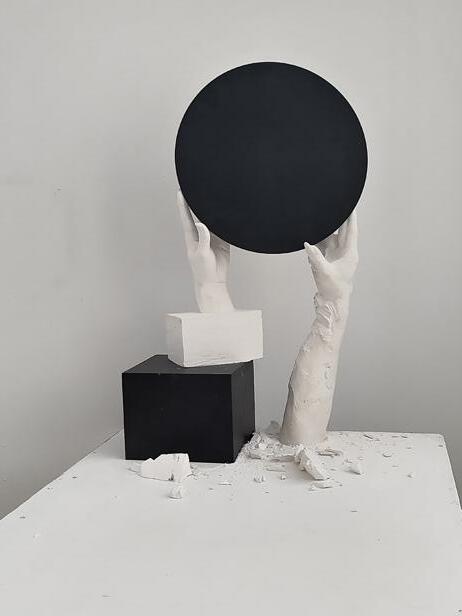

37 36
Acrylic Mirror
Acrylic, Paster, and Wood • 62x70x47cm
Iteration 2
Oil on canvas • 130x175x7cm
christopherhawkesart.co.uk Chrishawkes_@outlook.com @chrishawkes_
Chris Hawkes

39 38 Growth Ceramic, video • 200x10x80cm Yufeng Hu
huohuoji@qq.com @huhucares
behance.net/yufenghu2


41 40
What a bunch of dogs! Oil on canvas • 121.9x274.2x2cm
Silence is golden, isn't it? Oil on canvas • 40x50x2cm
Zhewen Jiang
zhewenjiang@qq.com @UK_VER._ZHEWEN
Research Groups Presence
Led by Michelle Hannah
Presence occupies an unstable position. It indicates both a condition in time, space, or state; we can be present to something or in the presence of something. It can be felt when there is a rupture, interruption, a blankness or even a failing.
What are the effects of presence and the sense of presence? Particularly in relation to the fragmented, somatic, virtual, sonic, performative and haunt-logical body. Is presence only ever brought into play by staging its antithesis…absence?
In this group we look to various artworks, thinkers, performers, archaeologists, poetic sonic worlds and an abstract eeriness that could potentially aid in an understanding of presence. In each session a select few shared work made in response to each essay or chapter. It was never a test if each individual has read them in depth, but in more in how they responded to the presence of the words through their own practice.
An individuals potency, which contains particular ways of perception, somatics and articulation in embodied forms; in the here-now, in its relation with the technological environment, materiality, the world-around-us, this dusty strange planet, stuck between a chasm… this thing of presence is quantum in scope.
LH: The closer you get to what you think something is, the more evident it becomes that it’s also an illusion.

MS: Yes. Absolutely. It’s a question of what truly constitutes evidence about who you are, about who I am.
LH: It’s always apparent in the flaws. You know, it’s in the crack in the wall, not the replication of it. I mean, that’s where the truth is.
It hides, waiting to be discovered.
MS: Yeah. It’s in the gaps, in the stuff that gets overlooked.
‘Archaeologies of Presence’, Lynn Hershman Leeson and Michael Shanks, p.228

43 42
Where I’m Calling From
Today we can contact anyone, the telecommunications company handles the contact point and transforms the connected nodes by digital arrangement. Through wires or underground cables, or undersea tunnels or communication satellites, we are in contact with each other, and huge computers control these. However, no matter how superior and precise the technology is, if we don't have the will to talk, then the telephone itself will not be able to contact anything. While we are constantly exaggerating that we are more intricately connected than ever in history, people's sense of alienation from each other is deepening. Our quest for individualism, despite the online communities we take part in, raises concerns about the future of our sociability.
These pictures reflect subjectivity and individuality, often including myself and my friends, depicting the disorder of life and evoking special states and fleeting moments: Who is making the call? What is this call about? How does the call end? These questions have inspired my impulse to pick up the camera to answer. If we’re lucky, photographer and viewer alike, we’ll remember one or two of those moments being captured and then just sit for a minute, quietly. Then, breathing evenly and steadily once more, we’ll collect ourselves, get up, “created of warm blood and nerves”, as a Chekhov character puts it, and go on to the next thing: Life. Always life.

45 44
Zewen Lai zacklai0302@gmail.com @zewen_laii
‘Where I’m Calling From’ 2023 Film photographic inkjet print, PVC, Plywood • 594x841x70mm
fenglongli.wordpress.com
Lifenglong999@gmail.com @Fine_gartbriel
Nurikabe (Getting Repetitive)
Microcontroller, Wire, Servo, Display, Ultrasonic Sensor, Camera •
300cm x 200cm x 200cm

47 46
Fenglong Li (Gabriel)


49 48
Tsaboo
Two-channel video installation projector and vintage CRT monitor • HD
20/40
Projection moving image • HD
fangjie530@gmail.com @fj.lin530
Fang-Chieh, Lin / Fj


51 50
The chains
Oil on canvas • 140x120cm
Leisure time Oil on canvas • 50x50cm
Lgy313243@163.com @guangyuan.liu.3344
Guangyun Liu
Symbiont
The human body is comprised of more microbe than it is of human cells. We as humans exist in the ‘symbiotic real’ with these micro co-inhabitants as well as other ecological entities. This intimacy between lifeforms can often go unnoticed until you become unwell or an outbreak occurs, but the majority of bacteria is beneficial to us, existing in our microbiome alongside other microorganisms. To remind ourselves of our coexistence as ecological beings in the biosphere is to recognise these nonhumans that we share the planet and indeed our very bodies with and to inhabit the Earth consciously as a symbiont.
The images in this installation were created through collaboration with bacteria cultures. Strains of bacteria were grown onto the emulsion of analogue photographic negatives, leaving their traces on the surface of this film. This left an image that has been co-created with the bacteria. An image created in symbiosis.

53 52 Symbiont no.3 analogue colour print • 63 x 28 cm Imogen Hero Imogen.locke91@gmail.com @imogenhero


55 54
Memories Puzzle—1 watercolour • 27cm x 19cm
lweilu1888@gmail.com @weilume1213
Memories Puzzle—2 watercolor • 27cm x 19cm
Weilu Long
Phantom Pain
Phantom Pain, as a condition whose cause is known but difficult for outsiders to understand. At the beginning of my practice, it provided me with a metaphor for approaching and grasping the core of this creation. At the same time, Phantom Pain, as a kind of hint, constructs a worldview that is very obscure and worth thinking about. The undeniable fact is that this approach, as I mentioned earlier, comes from years of attempting to view urban change through the unique lens of my own architectural profession and that of a firefighter. In many ways, Glasgow deserves to be discussed in this way because it is full of contradictory qualities, beautiful and sad. Early in the process, negatives were used to record the city's appearance, honest and neutral. The city's scenery and events were visualized and dissected like samples and files under a microscope. Such a situation mirrors phantom pain, a metaphor for the catholicization of urban phenomena.
"What is the pain of the city? It sounds so hysterical that every second, in many other corners of the world, there are more outrageous tragedies than this, and you've never seen those brutal, or pathetic, gestures in this city. It’s kind of pretentious."

"It's phantom pain, just like they do think amputation is just an extreme moment in their lives. They don't think that there is a plausible pain like a ghost that is always with them. And so, it is in this city. The perfect imagery of the products of brutalism, the seemingly intact but derelict remains, the traffic cones on the streets on the verge of death, the mockery of seagulls, the scars of the M8 highway."
I mumbled.
57 56 Canaan Digital photographic inkjet print •70x50cm Yen-Te, Lu andrew821102@gmail.com @lsdlu

59 58
Waltz floor
Yuchen Lu luyuchengjb@163.com
Oil on Canvas • 40×50.5 cm each, 1×13, (Variable arrangement)


61 60 Just like sandwich Oil on canvas • 25x20cm Works in progress various recycled and scavenged materials
veterok.net herracaligari@veterok.net @hautarauha
Elina Lundahl
Jieyi
Sympathetic Art Magic


Lithography on paper • 30x40cm
97.021822% Transparent Girl No.1
Oil on canvas • 25x20cm
maggiemak229@gmail.com @maggiekitz
97.021822% Transparent Girl No.2
63 62
Oil on canvas • 30.5x41cm Mai

65 64 Mind Your Head, Mind Your Heart II Acrylic Paint on Canvas • 212x170 cm
ryanm829@gmail.com @ryanfrancisfineart
Ryan Francis Robert Morton

67 66
Table (Part I)
Allegra Pedretti allegra.pedretti@gmail.com @allegra.pedretti
Foamboard, wood offcuts, cardboard, string, newspaper, wooden skewers, brown tape, paper pulp, blue paint • 62 x 115 x 55 cm
Table (Part II) Wood offcuts, cardboard, string, brown tape, newspaper, modroc, blue tape, paper pulp • 70 x 155 x 60 cm
Anthony Reed and Hannah van Hove
SAI STEPHENSON You mentioned world-making and lyricism, so I was wondering if you could tell us a little bit more about that.
ANTHONY REED Sure, thank you. That term is a kind of placeholder, I suppose, for thinking about some of the more narrow ways that some the corners of Black studies have of imagining what is a world; and often starting from questions of taking for granted the legalistic norms and codes associated with the nation-state, including those of emancipation. I think part of my punning with studying, which itself is a maybe untranslatable idiom (it's a way that people talk in the US deep South, like Nashville, like Mississippi), is wanting to say, lots of people have recognised that the state is not the vehicle for their freedom or their salvation and yet they've gone on about living and creating worlds with and among one another that as it were, isnt studying the state. They're not worried about that, or they treat it only in a kind of contingent way insofar as they understand how to interact with it so that their life can continue. I suppose I'm wondering how that might scale up to a broader collective project, ultimately a broader diasporic one. In Detroit, where I'm from, there's things like the African World Festival, or in Toronto there is the Caribana Festival, where people from across the diaspora get together in these public spaces and live their private lives in public, which is something I think that also happens in poetry. So, I'm not sure if that's going to really work as an explanation of world-making, in a sort of formal robust sense, but that's where I was trying to go with that: what are the worlds
that people who understand their oppression make for and with one another?
ALICE HILL-WOODS This is a question for Hannah: I was wondering how you navigated this kind of personal writing and strayed away from objective analysis to something that includes very important people like your daughter... How have you found transitioning into that mode? How much of your own life do you include when trying to create a critical lens to view other things?
HANNAH VAN HOVE It's something I'm still figuring out, really, but I guess more and more I've felt an urgency to position myself as a researcher in the narrative to draw attention to the subjectivity and the subjective aspect of doing research... And I think that's a quite important thing to do, because it feeds into this idea that research isn't objective, there's always a researcher that is a body in the archive, a body in the room. In my critical creative writing, I'm working on this larger project of thinking through what it means to do archival research in particular, and I've started inserting myself into the narrative, but it's a difficult balance to get right.
Friday Event — 09.12.22
FE, A.R. 69 68


71 70
harmony Oil and acrylic on canvas • 150cm x100cm x 15cm
Emotionally turbulent Oil on canvas • 200x100com x 10cm
angelahelenapieraccini.com angelapieraccini89@hotmail.com @ pieracciniangela
Angela Helena Pieraccini


73 72
Ghostly Hands and Black Page Wood, steel, acrylic paint, brush bristles • 42x32x11cm
Putrid Pamphlets Presents (Poster) Risograph print • 29.7x42cm
cargocollective.com/emilyritchie emilyritchie@hotmail.co.uk @emilyroseritchie
Emily Ritchie


75 74
Which
You’, 2023 Film
Three-Channel Video
• 1920
1080px ‘Untitled’, 2023 Acetone Transferred Print, Black and White 35mm Photograph • 14.85
10.5cm
‘That
Holds
Still from
Installation
x
cm x
ciorstaidhrhiannon.com kirsty.robertson18@gmail.com @ciorstaidh.rhiannon
Kirsty Rhiannon Robertson


77 76
Head in the Clouds
Mix media sculpture overlaid with digital drawings • 150cm x 226cm
Hall of Fame 1/4
iyla shah iylashah@hotmail.co.uk
Digital photographic inkjet print • A3
Jem Shearer jemshearer.com
shearerjemma@gmail.com @jemshearer
Macrosporange
Human hair, synthetic hair, toilet paper, lube, glycerine, borax and glue • 4cmx10cmx4cm

Does the Internet Smell? Internet history poem

79 78
Research Groups Correspondence
Led by Dr Marita Fraser
Correspondence is something we make, position ourselves into relation to and with, and an action in itself.
In the correspondence group we look at various methods of corresponding, from letter writing, copying and sampling, to see how correspondence operates as a method for making and thinking. We look at love letters, mail art, and art practices that consider the legacies of other artists; artists that write in the margins. We ask how is proximity to other artworks, artists, areas of research articulated through notions of corresponding to and with. What does it mean to correspond, the invitation to write to and from another, as art practice?

Dear Winifred, It’s true, I have tried on your clothes.
I’ve stood in your studio. I’ve thumbed your sketch books, read all your correspondence (Yes, I stood in front the Piero!) I too have walked the Cortile, climbed up on the roof and been drunk on Negronis. (Could it be together we fed the goldfish under the ilex?). I’ve stood on the highest balcony of the Villa Medici in the small hours and at some point later in the day momentarily glanced at Antonella da Messina’s youth and whilst the pairing of a grey linen skirt with a discrete cambric blouse makes perfect sense to me the painting still remains unfinished.
(from press release by Nadia Hebson - Moda WK, Lokaal 01, Antwerp, 2013)

81 80
IMAGES: (over) Photo of Winifred Knights in her studio at the British School in Rome 1920-1923 / (this page) Letters from the Winifred Knights archive from 1920-1923

83 82 Interwoven ‘Self’ Screen print • 51x68.5cms approx Niketa Shetty augs1932@gmail.com @tea_inks
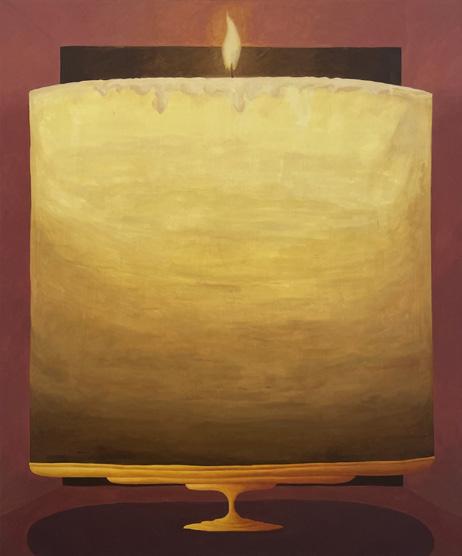

85 84
Big candle Oil on Canvas • 150x180cm
Face at night Oil on Canvas • 150x180cm
Ahmadsofi93@hotmail.com @ahmadsofi93
Ahmad Sofi
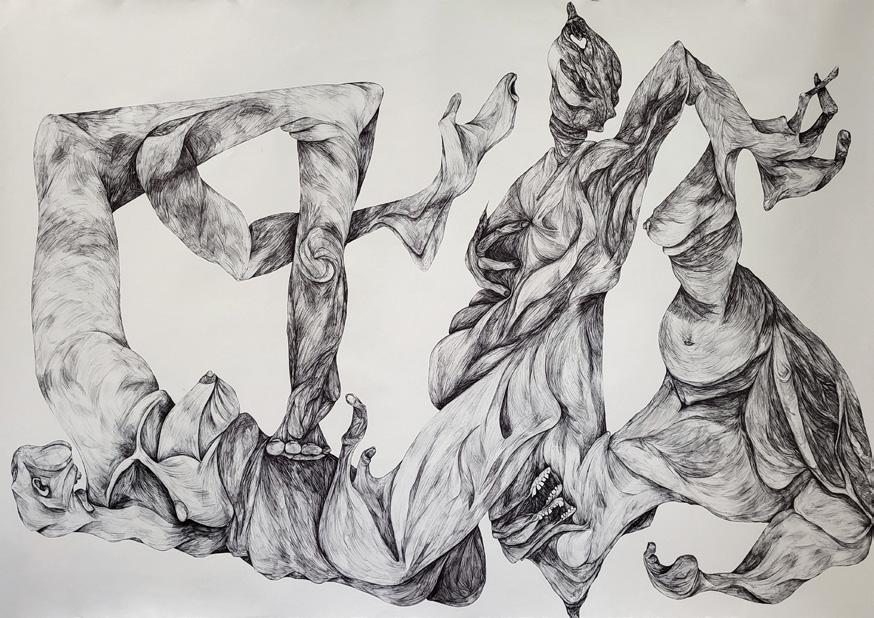
87 86 Allegory, Femme Ballpoint Ink Drawing • 220x150cm
sophietempleton@hotmail.co.uk @sophie_templeton
Sophie Rose Templeton
To seek what cannot be reached (fieldwork documentation) 2023


89 88
Digital photography
Silent Landscape I Watercolour on several layers of Tengucho rice paper • 20x25cm
Laura Viñas
lauravinas.com lauravinasgalli@gmail.com @laura_vinas
Research Groups Fiction
Led by Dr Jane Topping

There is a renewed interest in fiction and fictioning in contemporary art practice and our wider culture. The emergence of phrases such as ‘posttruth’ and ‘alternative fact’ into our cultural landscape is indicative of current challenges to truth, particularly as a mechanism for asserting political dominance (McIntyre, 2018: xiv). Reality has become a relative term, foregrounding and problematising perception in everyday life. There is, therefore, a political and ethical urgency for artists to engage fictioning as a practice, so that art might map out new territory, promote new perspectives and suggest alternatives to the political climate in which it is made.
Taking a broad view, our group discussed fiction at work in our practices, in the work of other artists and writers while considering on the potential of auto-fiction and sciencefictioning as exciting and pertinent frameworks of practice.
‘Art practice […] can produce new images and sequences – new myths, new dream worlds. An important aspect of fictioning, in this sense, is participation in the fiction.’
Simon O’Sullivan, Art Practice as Fictioning, 2015
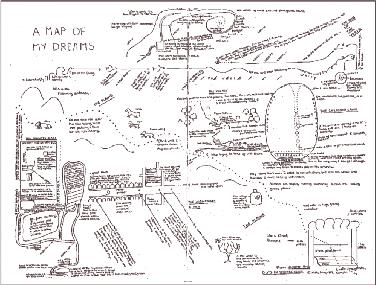
‘At a certain point I realized that the “I” doesn't exist. So I said to myself: If the “I” doesn't exist, I have to construct one, or maybe even more than one.’
Kathy Acker, Interview with Sylvere Lothringer, 1991
91 90
Self Portrait as My Sister Jane Wearing 2003 © Gillian Wearing, courtesy Maureen Paley/ Interim Art, London
Blood and Guts in High School, Kathy Acker, 1984


93 92
Transfusion
Acrylic on canvas • 100x100cm
Diary 19
Oil pastel on paper • 21x29.7cm
xinjingw59@gmail.com
Xinjing Wang
@rjinwww


95 94
Vernix caseosa Glass wax, latex • 46x30x10cm
Vernix caseosa II Wax, fishing line, metal • 48x33x6cm
ywu008@gmail.com @yoang.wu
Yongyang Wu
“La petite mort”
- My personal ruins
We exist in a space of personal ruins, constantly pacing, breaking, disenchanting, and reconstructing on it. Personal ruins are the residence place of memories, made up of layers of past experience. We eventually become our ruins by remodelling ourselves repeatedly through the fleeting loss of the consciousness of reality.
In this image-pervading era, perhaps "nothingness" is the real place where memories truly dwell, for it is where memories are generated, sink, float, blur, and restored.

97 96 La petite mort Audio and Paper Ashes Shuni Xu Xushuni1998@outlook.com @xu_shuni
how do we know that we live in a simulation?
photographic inkjet print • 83.5x55.5cm
hsiaohsuanyang.cargo.site hsiaohsuanyang1@gmail.com @hsiaohsuanyang1
I am now intrigued by the idea we may or may not be living in fiction How do we know that we live in a simulation?
The anomaly might strike you when you are walking down the street You would find glitch in your surroundings, just like computer files corrupted
I attempt to find the traces of it

99 98
Hsiao-Hsuan Yang

101
100
A Room in the Royal Palace Oil on canvas • 150x110x5cm Zixiaoyu2079@outlook.com @yuzixiao35
Zixiao
Yu
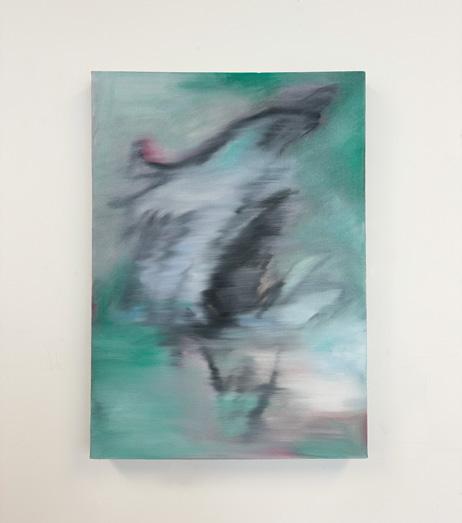

103 102 Shape Sound Oil Painting • 70x50cm
Oil
•
Ruolan beginruo@gmail.com @i_am_not_ruolan
On the Road
Painting
65x55cm


105 104
Colour Block Patch Plan: Turning Chaos into Order Digital photography inkjet printing, acrylic paint, Mixed materials • 51x68cm
Crossing the Visible Line Digital photography inkjet printing, acrylic paint, Mixed materials • 75 x 100cm
stde.cargo.site szt00700@gmail.com
Shaoting
@ssshhhaoooo_t
MLitt Curatorial Practice (Contemporary Art)


MLitt Curatorial Practice (Contemporary Art) 2022–2023

Approaching curatorial practice in a variety of ways, each student has explored methods by which they can articulate their practice, and modes of sustaining this. The students have positioned their work in thoroughly ethical, environmentally aware and politically conscious forms of curatorial activity. Through a diversity of forms, these students have filtered deep into the roots of Glasgow and beyond.
From Kitty Alvarez’s Dear You.., a self-assemblage zine focusing on friendship; Isabelle Belanger’s exploration of textile collections in Enliven: Connecting with Archives…; Peter Bloor’s intervention into nightlife with Club Critical: The dancefloor as a site of collective research; the publication For the
Time Being from Natkritta Chanmee delving into Japanese aesthetics and philosophy; How Does it Feel at the Nail Bar? a project and publication on reciprocity from Rosie Coleman Collier; an outdoor installation, Weaving Bodies from Eliza Coulson exploring bodies and nature; a film considering place and storytelling, in Which Way to Ailsa Craig? from Phoebe Crawford; with turnings.. Lucy Cunningham brings together a reading event and publication that considers the context of residency; Gai Yanni contemplates safety and creativity in the exhibition, A Room of One’s Own; located at Springburn Auditorium, Katie Garden’s workshop The Art of Dorodango: Connecting with Earth and Cultivating Mindfulness connects to a local community; with the exhibition Salamanders, Polly Gordon exploring our lives as networked subjects; Mackenzie Heiner curated shared stories around longing and desire with Our Love Lasts So Long; with Sandbox, Mollika Khandelwal considers speculative fiction as a vehicle for (re)imaging our lives; the jailed Russian activist-artist Sascha Skochilenko is the subject of Diana Tuma's exhibition Tides of Courage; Lily Liu’s Picnic Talks engages with ideas bound within the gig-economy; collaborating with the Alasdair Gray Archive, Janaki Mistry has developed The Travelling Archive Workshop toolkit for teaching in schools; with the resource and publication Subjective Feminist Genealogies, Ania Mroczek collates a range of diasporic and marginalised experiences in the UK; Weiwei Ruan’s dispersed publication
project My Wind Blows Me to This Direction: A Pocket Book of Spirituality and Healing brings you individual moments of joy to pass on to others; Sarah Scott’s essay experiments with both fandom and theory on the subject of the band, Sparks; ChiaChi Tsao imposed the weight of time wasting, labour and value in the group exhibition, Cost of Napping; Kyla Maeve Watkins looks to the natural world with her outdoor exhibition, Glasgow in Bloom; Tzu-Chun Wu encounters storytelling and personal accounting in the publication, Arranging a Narrative; inviting participants to consider belief and divinity, So Shan Yau’s group exhibition is titled, When You Believe; with Exist Once in This World; Chenfei Zhang’s exhibition explores consciousness in our real and online domains; YuShu Zhao challenged our understanding of AI produced art in The Humble Room; and Fan Zhao’s series of community workshops has produced The New Scots Cookbook: Recipes Sharing and Cultural Exchange with the Wednesday Women's Group, with accompanying video documentation.
We have also been extremely fortunate to have the support of our tutors this year, Yvonne Billimore, Lydia Honeybone, Dr Marcus Jack and Mason Leaver-Yap, alongside specialists Jenny Brownrigg; Katrina Brown; Dr Helen Charman; Prof. Sarah Cook; Ashanti Harris; Jessica Higgins; Eliel Jones; Dominic Paterson; Thom Rees; Chloe Reith; Dr Tawnya Selene Renelle and Dr Irene Revell.
109 108
Image courtesy of Alexandra Ross
Kitty Alvarez [she/her] is a curator whose practice is rooted in feminism inspired by Lola Olufemi’a Feminism, Interrupted and bell hooks’ all about love. Her current research explores print and distribution cultures and the ways this can be utilised as a mode of exhibition-making that follows feminism and a love ethic.
Alvarez’s research has culminated in a zine, Dear you, which consists of loose pages that can be (un)bound, rearranged and added to as the reader wishes, to create their own version of the published exhibition. The publication features works by artists Amy Strzoda, Asya
Dall’Agata and Esther Stone and poet, Bunny James, alongside scans of readings that explore love - living with a love ethic, love as a feminist method, and the way it has manifested in the lives of the artists. Letters written by the contributors and Alvarez invite the reader to contemplate these themes themselves, with space left between the artworks and readings for the reader to enter into this conversation if they wish to do so, by jotting down their thoughts or adding pages of their own. Dear you, aims to present an exhibition as an entry into a conversation, rather than offering a single narrative.

111 110 Dear you, Risograph and digital photographic inkjet print on paper • 14.85x21cm
Kitty Alvarez
kittyalvarez123@outlook.com @kittyalvarez_
Enliven: Connecting with Archives focuses on the interplay between design and archival research. This project explores the heritage of the work and archives in their safe space and how we can create environments for dialogue.

The project begins with an engaging workshop led by the GSA Archives and Collections team with support from designers Anita Sarkezi, Isla Fowler, and Niamh Clement. The workshop promises a valuable opportunity for knowledge exchange through the lens of these brilliant designers on unique objects from the collections.
Enliven: Connecting with Archives concludes with an installation featuring textile works by Anita, Isla, and Niamh, bringing forth an opportunity to juxtapose the archives with contemporary textile design. The works help bridge the gap between heritage and innovation, showcasing textiles inspired by such archives.
Isabelle Bélanger is a curator and graphic designer based in Ottawa and Glasgow. Her recent curatorial interests involve examining how curators and designers can enliven archival material, making it more accessible and captivating for contemporary audiences. Recently, Isabelle co-curated Uncomfortable Encounters (2022), a collaborative group project. She has also undertaken a five-month placement at The Hunterian Art Gallery which involved coordinating a social media plan for Unravelling Times (2023).
113 112
Enliven: Connecting with Archives Archives Workshop and Installation
isabelle.lizanne@outlook.com @isa_curatorial
Isabelle Bélanger
Syntax Deviant
Collective performance comprising installation, movement, sound, writing •


Dimensions Variable
amalg.install@gmail.com
@_amalg_
Club Critical: The dancefloor as a site of collective research
Roundtable discussion housed within an installation by Tamara MacArthur •
Dimensions Variable
115 114
Peter Bloor
This is a project that delves into the Japanese aesthetics and philosophy, taking the form of a thoughtfully crafted printed publication. The project serves as a guide for readers from different ethnicities and cultures, inviting them to explore the profound Japanese concept through photography. It explores the connections between creativity and the study of philosophy, particularly in relation to the existence, values, and knowledge embedded in different cultures. Emphasising the art of appreciating imperfection and fleeting moments, through the lens of participants from the art and design field, to engineer. Immerse yourself into this journey of Wabi-Sabi, photography and the power of prints.

117 116 For the time being Printed Publication • 120x210mm Natkritta
Chanmee kitabeing.com kitabeing@gmail.com
(Kita)
@kitabeing
Catherine Grant
ALICE HILL-WOODS Just to return to your idea of re-enactment, I was wondering how that might shape a writing practice?
CATHERINE GRANT That is a really good question and it's one that had different answers for me and it'll probably have different answers for you. What I started to do is to include more anecdotes or moments, both with artworks and also memories or experiences that started to feel like they did some of the work of the argument. So in a way, this idea of "a time of one's own", is both a reworking of Virginia Woolf's "a room of one's own" -- in asking what do you need to be a woman writer, you need a room, and money, so, financial security and space -- but then, also, when I was thinking about it, you also need time. A lot of us might have a room or a desk somewhere but not the time to use it. It is also about "a time of one's own" in the sense of, what times you bring together in order to create this moment of the contemporary that has this political affect? So, in my own writing, I started to have these moments of my own experience both with the work and in my own life as a way of creating a time of one's own on the page. I don't have a completely creative practice, I still write fairly straightforward art history but with an increasingly personal voice included. What I feel like a lot of other writers are doing who work in a more creative writing way, is to perform this re-enactment in writing through speculative fiction or science fiction or different forms of storytelling. For me has been a really exciting move that is not really within art history but rather in art writing or fiction. I feel like I'm drawing
more on those modes increasingly. And going back to the Julia Bryan-Wilson quote, that's somebody who writes very well within art history but is starting to become more flexible about the voices that are in her writing. I think for a lot of us who write art history, this is becoming an urgent question.

Friday Event — 21.10.22
FE, C.G. 119 118
how does it feel at the nail bar?

curated and edited by Rosie
Coleman Collier
how does it feel at the nail bar? is a journal dedicated to the act of getting your nails done. It takes the position of being situated in the nail bar as a prompt for creative and inter-disciplinary response; a mediation on the wider affects, intimacies, interdependencies, connections and labour that unfold through our painted nails.
The journal contains a collection of notes, correspondence and fragmented essays from three writers, clients and nail technicians drafted in response to being situated in the nail bar and developed throughout a series of working sessions. Emma Aars’s notes pre and post ‘getting her nails done’ is a diaristic mediation on the spaces in which we apply our nail varnish; in bedrooms with friends, airports lounges and the dim basements of a city salon, painting nails across each distinct spatial location comes to embody an unusual mix of discomfort and closeness with both ourselves and others. Becki Menzies writes a series of letters; to herself, a new client and a regular client as she details the awkwardness of small talk, the emotional and bodily labour of her work and the ‘blurred lines of business and friendship’ that unfold across the table. Kitty Grady writes on and through clippings, each titled in a shade of Essie and Opi nail varnish.
As a curatorial project, produced within and launched back into the site of the nail salon, how does it feel at the nail bar? serves as a reflection on expanded and reconfigured notions of the ‘curatorial’ as an intimate action; an attempt to redefine curatorial practice as a mode of relationality via the exchange of inter-subjective experience.
121 120 Hold my hand and dried flowers, June 2023 Image credit: Hold My Hand @holdmyhand.hmh
rosieecoleman@hotmail.com @rosieecoleman
Rosie Coleman Collier
Weaving Bodies, in which I am titling the exploration throughout the year, has manifested in many forms; Walking explorations, dissections of our interactions with the non-human world, artist walk and talks, crip ecology as well as the final project exhibition and publication in which can also be accessed via Soundcloud. Weaving Bodies for me has created an opportunity, as a curator, to engage with multifaceted layers of chronic illness, neurodivergency, grief, belonging and communication in context of land and the climate crisis.
The walking score, a depiction of my intuitive walks that share a connection between body and land communication and the publication a highlight of working with artists, with unique relationships with land, Adriyana, Ellen Crofton and Rosie Hart on Weaving Bodies exhibition.
123 122 Weaving Bodies Walking Score 2023 Digital graphic
J o l t i n g k n e se , Jkodlofogni ega eki hssenlli as concept of time Or t me s bound by misconcep noit o f i l senl s S i ckness . Slowly Slowly Slowly Swaying Motions Back and Forth, Back andForth . Held to get h e r yn peru pedeht.noisser deen ot yats tneserp . gniyawSgniyawSgniyawS . lSlwo y , Fda i n g , Away One step,onestep,then another step Foll ,snoitomehtgniwo .nihtiwsgnileefeht esuaP potS Go Pause . Inhale Exhale . Dark . Digressions of Thought Direction Change Incremental Elevation
@eliza_coulson
Eliza Coulson
elizacoulson.squarespace.com elizacoulson@outlook.com
Which
to Ailsa Craig?

‘Which Way to Ailsa Craig?’ is an explorative film which seeks to move towards a contemporary understanding of folklore through exploring how we write our own lived material to help us to make sense of the world around us. Set in the Scottish West-Coast town of Girvan, the project follows a failed attempt to visit the island of Ailsa Craig, in turn documenting a playful journey of personal discovery. Narrated by the voices of Girvan’s community, the film contrasts layered subjectivities in relation to place to explore themes of humour, oral-history, storytelling, identity and intuition.
Phoebe Crawford is an emerging curator, visual-artist, musician and researcher from Hebden Bridge, West Yorkshire, now living and working in Glasgow. Situated between artistic and anthropological ways of working, her practice is rooted in discovering ways to subvert dominant modes of knowledge production through conflating processes of art-making with nuanced, every-day encounters. With a passion for socially engaged art and community, Phoebe’s research is centred on understanding the value of personal discovery and lived material, and through this continues to explore themes of insight, memory, humour and intuition in her work.
125 124
phoebecrawford@live.co.uk @phecrawford
Way
Digital Film • 1920 x 1080 Phoebe Crawford
A film made by Phoebe Crawford in collaboration with Keir Richardson.
Lucy Rose Cunningham turnings
Sustaining sites of discussion, my work is a form of durational attentiveness. Through enabling time and space for conversations I forge close relations to practitioners; curating as a mode of learning from one another, of reflection and re-consideration.
During my time in Glasgow, I have curated Holding Hands and Kissing at Kiosk, co-curated Letters, with love at The Pipe Factory - exploring intimacy through correspondence art - and have supported the running of Hospitalfield’s residency programme. Working with Hospitalfield, combined with being in residence previously at Wysing Arts Centre, led to the production of my publication, t u r n i n g s, presented in this year’s Degree Show.
t u r n i n g s seeks intimate encounters with artists and curators across the UK, to explore the open-ended notion of ‘residency.’ Co-authors Lily Lavorato, Eliza Coulson, Ruth Dorber, Cicely Farrer, Dr Sarah Forrest and Alexia Holt address hosting; connectivity; precarity in the arts and housing today; access and positioning oneself beyond familiar environs.
(noun and verb) turning, plural t u r n i n g s
A place of a change in direction to reach somewhere else; to revolve around a point, retreat from, return to, durational; a forming by use of a lathe, a tool for making circles, slicing away at a surface to bring something together, circling back on itself, oneself, ourselves. To turn into something. The word conversation derives from two Latin roots, namely ‘com’ meaning ‘together’ and ‘versare’ meaning ‘to turn’hence conversation, the mode by which we explore our matters, is us ‘turning together.’
In the case of reaching sites of residency, Google Maps instructs numerous turnings.
127 126
lucyrosecunningham@gmail.com @lurosecunningham
A Room of One’s Own
“A Room of One' s Own” is a sustainable curatorial project initiated by Gai Yanni, consisting of an exhibition, a participatory workshop, and a retrospective publication.
A group exhibition (A Room of One's Own, July 10-13, 2023 - New Glasgow Society) showcasing works by Chinese female artists Chen Yiyang, Pan Wenyi, Wu Yongyang, and Yang Siqi. Immerse yourself in their "personal rooms," gaining profound insights into individual behavior and the plight of women in Chinese society. Through art as carriers of emotion, the exhibition encourages empathy, care, trust, and love.

An interactive workshop, "What can a room be and become?Shaping the space of our own " led by Dorka. Chinese women explore home space, transitional objects, and personal narratives. Unearth the room of the female body, society's gender roles, suppressed emotions, and more. Build a self-narrative, connecting with transitional objects that hold deep significance.
The publication "Room" chronicles this spiritual journey through a psychological healing lens, combining workshop outcomes and participant feedback. Reflect on the impact of others passing through us and the remnants they leave behind. Let this project empower and inspire women as it continues its mission.
129 128
Yanni71113@gmail.com @aro_omofonesown
Photos from the exhibition A Room of One’s Own Digital photographic inkjet print • 40x30cm
Gai Yanni


131 130
The Art of Dorodango: Connecting with Earth and Cultivating Mindfulness • Led by Sana Obaid Workshop Photographs
Katiegarden8@gmail.com @ktgardenstudio
Katie Garden
Salamanders
Salamanders is a Cyberfeminist exhibition that explores how our existence online impacts who we are away from the keyboard. Curated by Polly Gordon, this exhibition highlights how technology has served as an extension of ourselves as it increasingly intertwines with our daily lives. We trust technology to assist us in ways we believe harmless, but they are not neutral facilitators. We are willingly handing over our ability to think, learn and communicate – the things that make us uniquely human – to technology. As we become increasingly reliant on the Internet for information, entertainment and personal connection, we are inevitably losing something of ourselves. We become disconnected from the real world when we allow technology to assume more control in our everyday lives. To tackle this dependency, we must locate the point of injury – identify the parts of us that are damaged. Once these points of injury have been identified, we can begin to shed what we do not need from our relationship with technology. Like the salamander, we must regenerate. Grow a stronger limb; one that supports us in our effort to navigate the world we have created for ourselves.
Polly Gordon is an emerging curator, writer and researcher. Her research interests in Cyberfeminism and Xenofeminism have led her to explore theories of gender abolition and the plausibility of the Internet becoming a space for self-expression and identity exploration.

133 132
Salamanders Exhibition
Pollyg2510@gmail.com @pollyygordon
Polly Gordon
Mackenzie Heiner
installation for our love lasts so long

soundcloud.com/ourlovelastssolong/sets/our-love-lasts-so-long
kenzie.heiner@gmail.com @kenziecuratorial
our love lasts so long
Mackenzie Heiner [they/she] is an artist-curator entangled in themes of lesbian childhood, intimacy, and butch-femme historical and contemporary cultures. Working within the mediums of collage and sound, their work is driven by an aim to communicate the vulnerability of lesbian identity and memory. Heiner’s curatorial practice is born in the overlaps of their studio work and all the media they consume, taking notes from lesbian archives, textiles, domestic spaces, and poetry.
In Heiner’s final curatorial project, our love lasts so long, their research culminates in a gentle and intimate exhibition. Exploring embroidery, mending, making, and poetry as means of documenting precarious histories, Heiner’s show tasks its audience to consider how lesbian stories are passed down. It presents a shared diary, filled with poems, on personal audio players around an organically bound installation from artists Murphy Scoular and Lydia Budler, and considers all that is intimate.
135 134
Naturally sourced cotton, ribbons, beads, embroidery thread, lamp shades, sticks, handkerchiefs, and quilts • artists Lydia Budler and Murphy Scoular
What is the ‘purpose in worldbuilding’? Through a layered and interdisciplinary approach to exhibiting different narratives formed through research and fiction, ‘Sandbox’ aims to illustrate the nuance of escapism and the power of fiction in our daily lives.
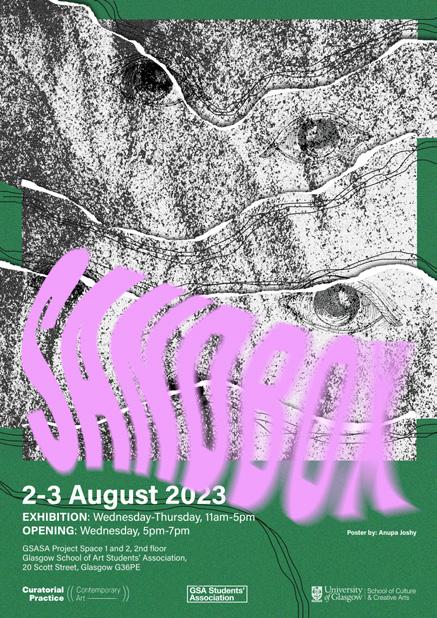
‘Sandbox’ brings forth the reality created by the artists to its audience. It explores the communicative role of fiction by engaging with the environment and object as a two-way street and seeing the “world as process” to communicate specific ideas. In worldbuilding, the communicative role of fiction engages in not only the content but the process of its creation and speculation, resulting in a communicative experiment. The exhibition juxtaposes sculpture, print, video and audio artwork to explore the dynamics between reality and fiction. The idea is realised through collaboration with Ditte Kroyer, Jennifer Elizabeth McNeil, Kathleen Crilly, Syautra Qotrunadha, and an excerpt from an in-depth conversation with PhD in Philosophy candidate Christopher Lynch Becherer.
Mollika Khandelwal is a curator working in Delhi and Glasgow, with a background in television production and a master's in environment, culture and society from Lancaster University. Her curatorial practice explores theories in the overlaps of worldbuilding and escapism through speculative fiction, drawing on philosophy and psychoanalysis to understand the catharsis escapism brings in an interdisciplinary, layered approach to research and display.
137 136 Sandbox Exhibition
Khandelwal
Mollika
Mollika.khandelwal@gmail.com @mollika_curatorial
The exhibition Sasha Skochilenko: Tides of Courage was curated by Diana Tuma in collaboration with the Russian Democratic Society. The aim of this show was to support Sasha's cause and raise awareness of the ongoing fight for freedom of expression and social justice in Russia.

Sasha Skochilenko is a Russian artist, musician and activist, who is currently detained for staging an antiwar protest and is facing up to 10 years in prison. Sasha's creative endeavours foster connections among people through displays of love and courage, with her art delving into themes of activism, LGBTQ+ rights, and mental health. In the video works showcased at the exhibition, Sasha touches on themes of escapism, change and loneliness. The show also presented documentation of Sasha’s trial proceedings, or what she calls, her performance art piece Imprisonment. In these records you can read the inspiring story of Sasha’s perseverance in her fight for justice and freedom of expression.
Diana Tuma is an independent curator and writer working with a background in theatre-making. Her practice can be described as embodied activist curating. This articulation of the practice emphasises performance and performativity as an occupation of space both physical and incorporeal in which activist, feminist, queer and emancipatory methodologies are enacted. Her recent research has been centred around the issue of censorship within the contemporary Russian art scene, exploring how artists opposing the war and the regime can be supported.
139 138
Sasha Skochilenko: Tides of Courage Exhibition
Tuma Mayatuma7@gmail.com
Diana
Picnic Talks: work and life curated and edited by Li (Lily) Liu

In China and some other countries as well, many people are used to working from 9am to 9pm six days a week, aka “996”. The workers are often burned out due to the unintentional part of work, just like a special form of mental violence. As reported in the book “Bullshit Jobs” by David Graeber, an American anthropologist and anarchism activist, nearly a half of people considered their jobs meaningless. But what is the real meaning of work? To what extent do the workers identify their jobs as bullshit? What’s more, the boundary between work and life has been becoming blurred. Hannah Arendt divided Vita Activa into three forms: labor, work, and action. In the context of the capitalist system in modern society, labor and work have transformed into productive labor. The ethical and moral standards of work and its control over time have led to a loss of the sense of meaning of work for some people. Artists and curators use artistic forms such as performances and public events to explore and question aspects such as work and time, productivity, publicity, and feminism. At present, it still has practical significance to re-examine and reflect on the significance of work.
“Picnic Talks” is a part of the research project entitled with “Labor and Work” by the curator Lily Liu and artists Chao Zheng and Ahmad Zaim Zarif. This project aims to explore the mutual interconnections and influences that occur between work and life outside of work, highlighting the subtle impact of professional training on our existence. The artists conducted follow-up interviews and filming with multiple workers in the same profession, and invited them to picnic conversations. On the day of the exhibition, performance art pieces have been designed, including the interaction between the artists and the visitors. Altogether, these works will invite others to reflect the impact of labor issues.
141 140 Image
Li (Lily) Liu L.Liu3@student.gsa.ac.uk lily_liu121@ins
by Chao Zheng
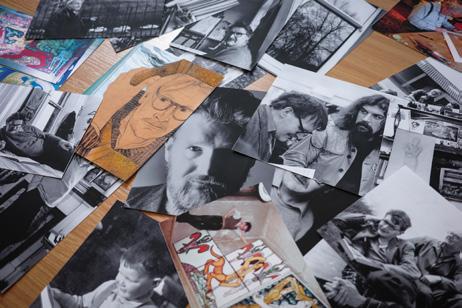

143 142
The Travelling Archive
Close up of contents, Images of Alasdair Gray • Image taken by Alasdair Watson
Janaki.mistry@yahoo.co.uk @m_i_stry
Janaki Mistry
The Travelling Archive Close up of contents • Image taken by Alasdair Watson
sfg-project.com
aniamroczekart@gmail.com
@ania.curatorial
Subjective Feminist Genealogies collates individuals and projects exploring diasporic and marginalised experiences in the UK by offering alternative histories and reframing existing narratives through a genealogical lens. It guides those displaced or dispossessed as a reminder that they are seen and recognised. This project signifies a space that allows them to speak and be heard, where they can subvert and repossess their histories and experiences. It aims to provide them with the agency to pave the way for the representation of their diasporic identities and situated knowledge.
This project unites four practitioners and projects through a printed publication, exclusively shared with those involved, and a web platform open to others. The website features content akin to the physical text and fosters collaboration, networking, and community growth, offering a wider audience with digital resources and interactive engagement.
Ania Mroczek, the curator and artist behind the project, resides in Glasgow and explores feminist genealogies and the reinterpretation of historical narratives through subversion. Her work challenges dominant assumptions and power structures and focuses on marginalised perspectives. Ania is currently pursuing a Master's in MLitt Curatorial Practice (Contemporary Art) at the Glasgow School of Art, having graduated from the University of Lincoln, Lincolnshire.

145 144 Subjective Feminist Genealogies Softcover handbound A5 publication • 148 x 210mm Ania Mroczek
Easy to carry, to read and share, My Wind Blows Me to This Direction, is a publication project that presents artist interviews and selections of artworks and images that explore ideas of spirituality as represented within art. Invited artists, Xin Huang, Susan Yau, Yongyang Wu, Dorottya Szanka(Dorka) discuss the artworks and ideas that nourish and renew them in a series of interviews accompanied by a selection of images contributed through an open-call for submission. All of the contributors draw from their own experiences and genuinely share the spiritual atmosphere and healing power they felt from the different types of artworks, and together they create an intimate, harmonious atmosphere in the pocket book.
Ideally opened at random in the intervals of time (such as coffee breaks, waiting for friends, queuing, taking transportation, sunbathing in the park), it is anticipated that the texts and images in this little book, will produce positive energy. Join in by putting this pocket book in your pocket and the pockets of those you care about, in the hope that it will go anywhere in the world and become a travelling pocket book (it does not need a passport and visa).
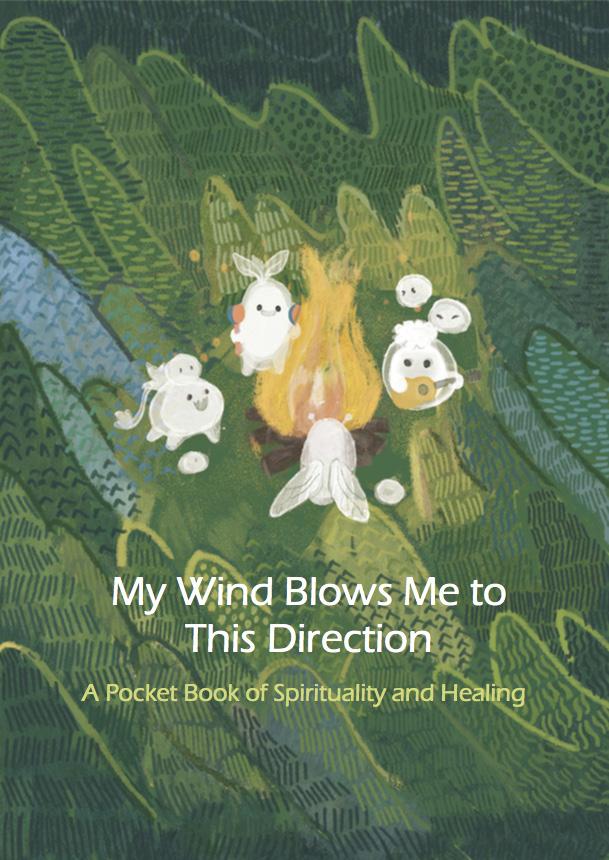
147 146 My Wind Blows Me to This Direction: A Pocket Book of Spirituality and Healing Printed Publication • 105 x 148mm Weiwei Ruan kiwilovegsa@outlook.com @kiwi_summertime
“There’s the bands who are wildly popular in their day and adulation, and then there’s bands that sow all these seeds and foment all these ideas that grow up in other places. And there’s some corollary in nature. Like, we wouldn’t survive without the bees. Sparks are part of the ecosystem of music.”

- Beck1
Through a contrapuntal combination of textual analysis and fannish experience this project explores the band Sparks: their influences, and the ways their fans have been influenced by them. Focusing on three specific works of their more recent and current career, this collection of writing aims to arrive at a better recognition of the perspectives on contemporary culture that Sparks through their work demonstrate: a respect for the artifice of performativity and the conceptual urge towards a generative understanding of popular culture.
Intertwining these exegeses are personal diaristic accounts and musings regarding my experiences with the band and its fandom, tying together the academic and the experiential, the audience and creator, and artist and curator. Thinking about the ways people often create relationships with art and form a sense of identity and belonging that surpasses categorisation, my work serves to highlight the necessity of an artistic rhetoric centred around fannish joy. There remains a sublimity of experience that can only be illustrated, not interpreted. This project is an illustration towards an interpretation which while starting with facts, can only reach a subjective apogee.
1. Wright, Edgar. The Sparks Brothers. Blu-ray, Focus Features, 2021.
149 148
Sparkstember Day 28: Favourite Song by Roos Kortenoever digital illustration; PNG file • 1300 x 1300 pixels @alittlebitlikefun
Sarah
Scott
A Little Bit Like Fun: writings on Sparks and fandom
Chia Chi Tsao (Violet) is a curator who has been exploring the relationship between human existence and the system. More specifically, she is interested in biopolitics, sociology and philosophy. The latest field Tsao has been focusing on is Time. Starting with slow cinema, Tsao expends research on time feeling, duration, time value, Accelerationism, labour and consumption.
In Tsao’s final curatorial project, COST OF NAPPING, time is discussed as a topic in relation to a systematic world. The exhibition addresses ideas of TIME IS MONEY in the context of the experience economy and the ways in which profit has become synonymous with value. Featuring artists Chih-Kang Hsu, Meray Diner, Vytautas Bikauskas and Maria-Cristina Onea, Tsao titles herself as the curator and the time dealer by putting up an exhibition of artists who utilise their own approaches toward Time, while she also dominates artists’ labour time. She reflects on the topic by switching her own role.
The aim of COST OF NAPPING is not to propose solutions or alternatives, but simply to illustrate that we all live in this Mobius strip-alike cycle, putting up our tiniest, personal resistance every day. The hope is to make such struggles visible and soothing with the theme of time.

151 150 Exhibition views from COST OF NAPPING Chia
Chi Tsao (Violet) violet.cc.tsao@gmail.com @violet_chi_curatorial
Glasgow In Bloom: Celebrating Nature and Sustainability

Glasgow In Bloom explores the relationship between art and the natural world, both thematically and practically. The exhibition features artwork by three Glasgow-based artists whose practices are linked through themes of nature, and their eco-conscious methods. By displaying the artworks in a garden, Glasgow In Bloom highlights the connection between the beauty of nature, and the natural and sustainable possibilities in exhibitions, creating an environment for a celebratory, immersive, and reflective experience.
This exhibition explores the possibilities of sustainable alternatives for an industry that typically produces large amounts of waste. In order to mitigate this exhibition’s impact, the curator and artists used natural, recycled, or secondhand resources. All the curatorial methods were executed with minimal consumption, using resources already available rather than creating something new.
Kyla Maeve Watkins’ curatorial practice revolves around the idea of ‘complete design,’ a methodology of holistic exhibition design using the location and display to enhance the narrative of the artwork. Watkins is also invested in supporting and growing sustainability and accessibility within the art world and her professional curatorial practice. She hopes to establish herself as a curator who innovates immersive, display-oriented, narrative exhibition styles, upholding the values of sustainability in the Glasgow art scene.
153 152
Kylamaeve.art@gmail.com @Kylamaeve_art
Kyla Maeve Watkins
Arranging a Narrative is a publication that encourages readers to examine thoughts and emotions within narratives. As we reflect on life and examine the thoughts we had, we find different perspectives we couldn’t see before; we can learn from our past and understand its impacts upon us. We gathered, through open submission and direct invitation, a series of such flashbacks and reflections. The storytelling process can be looked at as a form of journaling; each art piece becomes a part of the documentary of a certain aspect of one's personal journey. This project offers an opportunity to confront memories and emotions directly.

Visit tinyurl.com/CPCANarrative for digital launch and get an ebook copy before the degree show ends.
Tzu-Chun (Julia) Wu is a curator and graphic designer based in Glasgow. With an interest in exploring the relationship between people and their surroundings, as well as their inner thoughts, Julia looks into how these can help create a narrative for the unique life experience they have. Their research focuses on the visual aspects of a curatorial setting and how the use of visual elements can elevate the storytelling experience. Their practice explores the potential of publication across both traditional and digital mediums.
155 154 Arranging a Narrative A collection of zines, print on paper • 140 x140mm
@julia_tcw
Tzu-Chun (Julia) Wu juliatcwu@gmail.com
PÁDRAIC E MOORE
There's a tendency maybe to approach art solely as a purely aesthetic or purely kind of professionalism ways of thinking about intellectual thread. And I suppose I'm fundamentally interested in the utopian function of art as a force within society. And with that comes the potential for transcendence and the possibility of a communal way of communicating that I think has probably been disallowed to most of us who have grown up certainly in quite a sectarian, I mean I grew up in a very atheistic environment. It’s the search for the spirit in things that can also help me connect with my fellow humans. I see art is a fundamental tool in that kind of process. Sharing this path with you is as much about me constructing a space that I can exist in as a human being, as it is trying to carve out a kind of professional pathway. That might sound kind of messianic in a way, but I suppose it's more about like trying to contribute to a world that I want to live in. That involves talking to artists and trying to share these ideas so we can build them together. There's a huge amount of material in the past that is a helpful way of negotiating this. There's a lot of value to be mined from yesterday.
I think we're also witnessing a collapse of post-war infrastructure that was put in place that has now become so explicit that it's impossible to deny that it's happening. But that's also coincided with a kind of atomisation that hasn't really existed before, which is also to do with the kind of privatisation of the self and the psychic privatisation. So, what I'm trying
to point to is methods of communication or togetherness that are not attached to, that are maybe using the language or the aesthetics of spirit infused kind of movements. But yes, I do believe we are living in a time of unprecedented disaster and collapse, and that is creating huge amounts of psychic trauma, which isn't being physically manifest anywhere outside ourselves. This is where culture becomes a space that we can try and form new languages. My preoccupation with looking at all these past episodes are about not only world-building but trying to find methods that read and analyse and at least accept the presence of these kind of psychic states of being. Another thing that I've tried to point to today is that up until halfway through the 20th century, huge parts of... we've become very rational in our thinking regarding various possibilities, regarding ourselves as a species, but also, you know, what art can be. I'm interested in those episodes when that kind of stratified or compartmentalised way of thinking hadn't really happened yet. And the hope is that we can recuperate or rebuild some of those possibilities.
We're living in this world of curatorial saturation where the term itself becomes so ubiquitous that I don't think it actually means anything anymore. And that's coincided with the rise of various online technologies being utilised to describe a form of collecting or presentation of all sorts of material. So probably in the last two decades, that ubiquity has taken away kind of some of the sensitivities that I wish it still had. I think it should mean, to care, which is part of its etymology.
Friday Event — 11.3.22
FE, P.E.M. 157 156
Pádraic E Moore
Susan Yau, who was born in Hong Kong, explores Christianity, mental health, and memories, drawing on her background in creative writing and film arts. Through film photography, prose, and installations, she demonstrates her belief in the power of art to inspire healing and positive social change. Susan also loves traveling, which broadens her perspective and enhances her line of work.
Her curatorial final project, "When You Believe...", delves into the challenges of finding true joy amidst the fast-paced, stress-laden modern life. Incorporating the emotions and relationships of every living creature, the exhibition illustrates joy as a practice within a simulated world, immersing viewers in an interdependent environment.
The project explores joy that transcends circumstances and is rooted in faith and hope in God. In collaboration with four Christian artists, the exhibition generates a space that provokes reflection on the transformative force of happiness. The audience is invited to investigate the complexities of happiness and its profound effect on individual and communal well-being.

159 158 Genesis of “ When you believe…” Video Yau So Shan Susan susany19@icloud.com @susanyauuu
Chenfei Zhang is a curator who pays attention to the connection between humans and their surroundings. She is interested in sensory experiences, immersive atmospheres and interaction. Recently, Chenfei’s practice has focused on the possibilities of human existence and consciousness in the context of technological development.
Exist once in the world is a duo exhibition whose title is taken from Albert Camus’ The Rebel: An Essay on Man in Revolt, where the author remarked “In order to exist just once in the world, it is necessary never again to exist.” It is from this paradox that the premise for this exhibition is placed; based on our awareness and emotions of the real world.
The exhibition provides a simulation space where artists have considered how to view and describe the future existence of human consciousness. The artworks on display include paintings, videos and publications by artists Zijing Chen and Hsuan Yang. Placing the viewer between reality and the virtual, between image and data, between what we see and what we feel. This exhibition is not an attempt to replace the present moment through technology and fantasy, but rather an attempt to find a balance between reality and virtual existence, to feel the connection between reality and the virtual world.

161 160
Chenfei Zhang fayegouw9@outlook.com @fayeah_9
Exist once in the world Exhibition
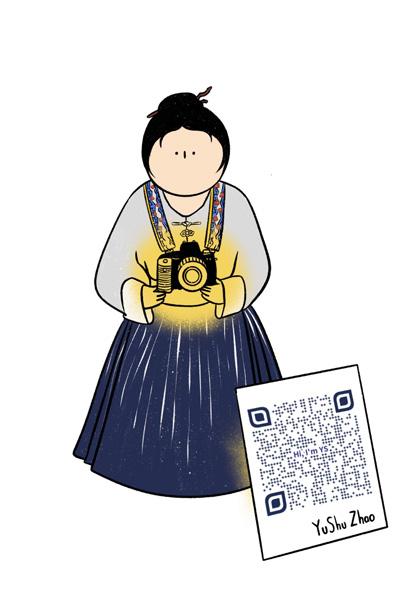

163 162 A Humble Room Exhibition & Publication • Poem & AI YuShu Zhao YuShu.ZHAO.125@gmail.com @wild_curator_YS
The New Scots Cookbook: Recipes Sharing and Cultural Exchange with the Wednesday Women’s Group Curator: Fan (Yvonne) Zhao • Illustration: Yucheng (Erin) Chen • Poster by: Yutong (Ivy) Chen • Publication size 28x20x15cm

The New Scots Cookbook: Recipes Sharing and Cultural Exchange with the Wednesday Women’s Group is an art project where women of Milk Café engaged in a series of workshops via the lens of food, culture, and hospitality.
Wednesday Women’s Group is run by Milk Café, a social enterprise seeking to support refugee and immigrant women. It centers on building meaningful connections with strength and resilience. Locating The New Scots Cookbook project in the Milk Café worked with this generous and open structure to allow the participants to come into the project when their lives allowed.
The project collaborates with artists Alia Mobarik, Asya Dall’Agata, Yucheng (Erin) Chen, and designer Yutong (Ivy) Chen. Through a curatorial approach the project seeks to foster understanding and cultural appreciation by engaging these women in collaborative food preparation, communal dining experiences, and oral history telling in an artistic way.
Fan Zhao (Yvonne) is a curator and sculptor based in Guangzhou and Glasgow. Her recent curatorial interests involved hospitality in the community, preservation and visualization of oral histories. The artist's background makes her focus on how to facilitate/ transport artistically. Also, she has undertaken a five-month placement at The ATLAS ART, isle of Skye, exploring the manifestations of hospitality in curation work.
165 164
(Yvonne) zevantffan@gmail.com @yvonne_zzffan
Fan Zhao
MLitt Art Writing


MLitt Art Writing 2022–2023

It’s the fifth anniversary of the Art Writing programme and we have gratefully celebrated this with another year of good writing, variegated thinking, and brilliant conversation. Kate Briggs concluded her time with Art Writing as the School of Fine Art’s inaugural Practitioner in Residence with a Friday Event lecture ‘A Social Process of Unknowing Yourself in Real Time’: Work on Conversation.
In autumn 2022, we presented the second part of Biographical Fictioning, our Open Studio project, this time focussing on The Lyric, and, stemming from this, we are delighted to publish an anthology of new writing, This is not a biography*, edited by Laura Haynes, Alice Hill-Woods and Kate Timney. For The Lyric we were joined by artists and writers including Claire-Louise Bennett, Nicky Coutts, Laurence Figgis, Michael Pedersen, Margaret Salmon, and Susannah Thompson and together we spent two days querying how poetry might live in a space between subjects. Looking to the forms of attachment, homage and preservation present in the impulse or desire of writing with or about others, we asked how profound knowing might require the affective, creative, and vernacular dimension of the lyric.
In workshops, in tutorials, in new work, the Art Writing cohort have been preoccupied with atemporality, opacity, reading, with the play of (auto) biographical, ancestral, cultural masks, with formation, unsaying, and new ways of conceiving the everyday. These discussions have taken place in the moment of Kate Briggs’ attention to the site of conversation in an art school. On a sitewriting fieldtrip with artist and writer Maria Howard, where students visited the Hamiltonhill Claypits and cultivated shared somatic knowledge of material and site. In April, with Brian Dillon as part of the launch of Affinities, published by Fitzcarraldo Editions, and with Daniela Cascella at Good Press for the Glasgow launch of Chimeras
(Sublunary Editions) and Nothing as We Need It (Punctum Books). This year we presented Soft Shell again at The Poetry Club and interim exhibition, Boys with Books, at French Street, Glasgow, and were thrilled to be joined by CAConrad who delivered a full length reading of The Book of Frank. Now we present Tongue & Groove, an Art Writing showcase held between Stow and CCA Glasgow, alongside publishing the fourth edition of The Yellow Paper: Journal for Art Writing.
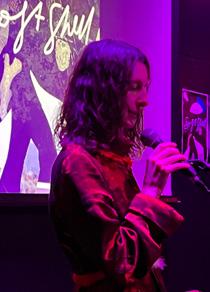
169 168
Publishing & Publics Art Writing Intensive,
Olivia Wiles, Art Writing: Soft Shell, The Poetry Club, December 2022
Image courtesy: Neil McGuire
Remembrances and Confessions Volume I Camilla,
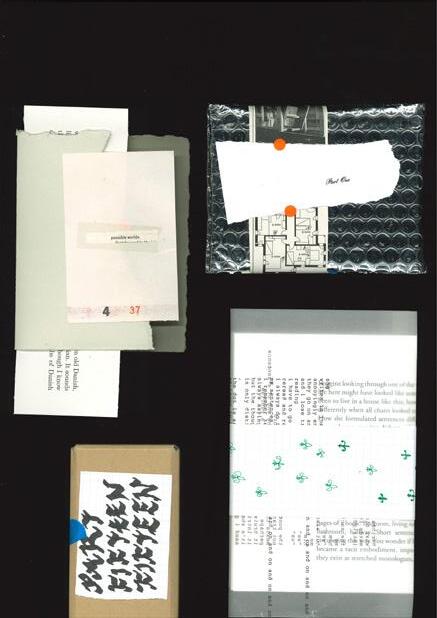
It is late July, and the curling plant has unfolded by now. In a city quieted by summer and the construction work closing off the otherwise busy Great Western Road, I am left with the sound of occasional gardeners as I walk to the studio in the morning. Each of them with their own electric gardening equipment, making loud noises, turned on and off in intervals. Trimming hedges, clearing out the weeds. I look beyond the ornamental fences where my eyes usually stop, and see a gardener cutting away heaps of the plant with no name.
Like watching the gardener at work on the other side of the fence, I read your writing from the other side of your marginalia. I am not really sure whether to let myself in – if I am allowed in, or if time passing slowly takes shape as a barrier between us, where I can only observe your world from a distance. Translating your work is a repeated attempt to cross these fences, yet sometimes it simply ends up as a reminder of the persistent boundaries between us. Time passed –languages, too. My translations are bad and inaccurate. I try to decide whether I should attempt to see the world from your side or mine. Or if I should focus on the sparks of your writing that – albeit the old-fashioned language – still feeling just as relevant, making the time between us collapse.
171 170
Remembrances and Confessions Volume I
Scan of different parts from artist’s book • Various paper types, cardboard box, silver bubble wrap, orange sticky dots, calligraphy pen, tape
Aars emmaaars.com
@nicehangover
Emma
emma.aars@gmail.com
Cartographic translation: Juan Mayorga’s “La gran cacería”
Digital scan

173 172
maria.garayarriba@gmail.com @mariagry_
María Garay Arriba


175 174 A Report on Spores Video, Sound Braiding Video, Sound Gianni Esporas gianniesporas.com gianniesporas@gmail.com @gianniesporas
Kate Briggs
JAMES EPPS What do objects do in a ritual, especially in the context of an art school? I think we’re probably more from an object-related thinking background, how’s that affected you as a writer?
KATE BRIGGS I really like this title we came up with together: Rituals in Preparation for Talking About Someone Else's Artwork. It holds a provocation inside it, I think. The idea that we might need some rituals. We might need some preparation, different forms of preparation for talking about what the artwork is doing. But: objects. Yes. There is, even or perhaps especially in art school, all this emphasis on talk and language and language production around the object, whereas, as an artist, you might be interested in materials and objecthood, precisely because it's not linguistic and doesn’t partake of language. We're only just at the start of -- I'm only at the start of thinking of about this: what it might mean to invent ways of exchanging thoughts about art objects and registering their presence without necessarily dealing with language, without necessarily resorting to the English language, always, of all the available languages… As for the last part of your question: working with an alongside artists who have different relationships to materials, has had a huge impact on me as a writer. I guess, to answer briefly, I am always thinking of the book as a peculiar kind of object, and I’m very interested in how it takes up space in a room, for example, and how it behaves in relation to other kinds of object.
AUDIENCE QUESTION I always admire this very astute way you have of setting ideas within specific situations. I think this has an element of accessibility to it: you come from this very academic way of learning, but then you write about these everyday situations. Could you talk about that relationship, about the kind of power dynamics involved?
KATE BRIGGS Thank you for this. I do get a kick out of moving between registers. In the passage I just read, it was inspired in part from reading Gilles Deleuze, and these very beautiful descriptions of what it was like to speak with Michel Foucault, and then what it is to have conversation more generally, or abstractly. I did enjoy translating something of that into a scene between two women queuing to get into a club. I think this desire to keep grounding ideas in specific situations comes from a belief that ideas are everywhere. I mean, everyone's thinking seriously about their work, their lives, all the time. It's not just the philosophers who are struggling with the big ideas: in the The Long Form, everyone's thinking, in their own ways. There's a baby in the novel who is also thinking. There's an effort in the book to describe this nonverbal person also thinking, living, a sensational being playing her own part in the action. I wanted to write from that position, as a counterpoint to the adult narrating position, for the reasons you're describing in the second part of your question -- this power dynamic. One open question which runs through the book is: Who is in charge here? Who decides? The adult? The baby? The larger social forces? What is this shifting exchange of power? The novel made a place to explore these questions…
Friday Event — 31.03.23
FE, K.B. 177 176
I’m walking, and it’s hard to ignore the birds. They have become a serious soundscape. They are the instrumentals behind this experience. And I think about that one night where we sat in my living room. The moment before was a quiet one. We sipped our weekly can of beer, and then the birds began to chirp. Those night birds, the ones I hadn’t heard for weeks now. Surprising at first when they would start up late at night, but were slowly becoming a part of the landscape of the flat. Then all at once, they disappeared. But here and now they had resurfaced as a separate entity—a signaling of something sure to come. You turned your head slightly towards the window, trying to listen harder, and said, Do the birds always sound off this late? I looked at the side of your face, side of your nose, side of your neck, and said, Yeah, they sometimes do. They don’t usually wake me up, but they do make noise this late. It’s weird. It’s something I’m getting used to. Huh, you said both perplexed and waiting, head still turned away, I don’t know how you’d get used to that. Yeah, I said both perplexed and waiting, eyes still turned towards you, I don’t know how either. It just happened. I guess I just stopped listening for them.

179 178
Speirs Wharf (2022)
Portra 800 35mm film (scanned) flahertykelcey@gmail.com @kelceyflaherty
Kelcey Flaherty
The Birds at Speirs Wharf
Distilled Vapours
Crazed typewriter tapping and an unsteady hand seeking clarity. It seems to me that the city is littered with advertisements to advertise. Blank space and empty poster frames reminding us commuters that you are sellers or sold to. Life as a game of enticement. Our magpie-like draw to coin. I have encountered many a productivity tip which suggest the personal use of rewards - ‘if I write these 200 words, I can eat some cake’ - but monkey brain is fully aware I could just eat the cake now. My self-control bending to stubborn arguments of logical fancy.
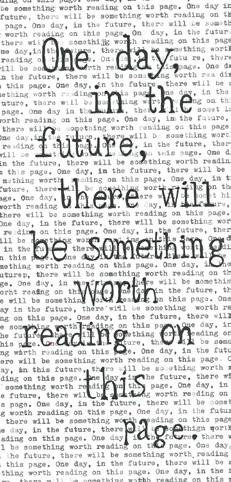
The lonely charcoal through line. Resonating in the spine. My heartbeat so moves my fragile body and before I try to move my limbs, I know this is not a day I can leave the house. I will call it a success to leave the bed. I am trying to reframe flare ups in immobility as a spiritual state of seclusion. Trying and frequently failing. But in the act of retreating, I become aware that there is something I need to learn. I cannot hazard a guess as to the realm of this wisdom, but I can feel that it is not discoverable in the noise of humankind.

181 180 Strength & The Hermit Ink and Charcoal Tarot Cards • 8 x16.5cm each E. M. Foster E.M.Foster@outlook.com


183 182 Reconstructed Home Moving Image • 23 minutes 58 seconds
Reconstructed Home - Meditations Exhibition Print • A5, 12 pages
ionamarshall1.wixsite.com/wordsbyiona Ionamarshall1@gmail.com @plethoraofi
Iona Marshall
Theo
With a tendency towards aftermatter
Sculptural installation comprised of; handmade paper, water, dust, hair, PVA, salt, soil, glass wax, microcrystalline wax, steel, iron powder and borax.

theohynanratcliffe.wixsite.com/mysite
theohynanratcliffeartist@gmail.com @theo_hynanratcliffe_
With a tendency towards aftermatter
When I was little we had a disappearing lake at the back of our house.
It would keep disappearing and being all at once long after we left, and well before we came.
The lake would breathe in and out, expanding and contracting like lungs.
And this is where time would build up like silt.
Coating the rocks.
Making paper out of time itself.
And I remember thinking that the lake can birth form all on its own.
This is where I learned that time was physical, was a measure and a body all of its own.
With a tendency towards aftermatter is a publication and sculptural installation in which material bodies move through processes of aging and changing posture, oxidizing, crystalizing, slumping, holding.
Through auto-theoretical and fictional re-weavings of memories the work proposes a material attention to human and more-than-human matter, exploring attention to physical accumulations of time, and human tendency towards the generation of matter. We follow our protagonist as she casts the kitchen table in her family home, and carries it in pieces across the sea between County Clare, Ireland and Glasgow, Scotland in a suitcase, holding the presence of the site’s body and memories inside the casts and material residues. Through these practices of revisitation she considers her experience of learning sited in the language and materials of place.
185 184
Hynan-Ratcliffe


187 186 Dear Popo Digital illustration • 21 x 29.7cm
At The Table Birch plywood, steel tube, beech, pine, oak, artist book • Variable sizes
aureliechanhonsen@gmail.com hundredpercentrice@gmail.com @hundredpercentrice
Aurelie Chan Hon Sen
An interstice is a small gap, a crack between, a seam or aperture, from the Latin to stand between. The book presents moments of in-betweenness: post-lockdown, post-illness, post-industrial; across the course of a weekend, where a journey breaks down and a narrator waits out a storm in their parents’ house. Feelings of political frustration and disorientation are pitched against attention as a mode of optimism, with a closely held gaze that documents the details in the weather, the landscape and lives that fill up the weekend.
To each detail described, associative images and notions attach themselves until the writing begins to illustrate the act of looking— locating a body and a self through absorption in its surroundings. There is the image of a train, halted in a blank white landscape; a beach frozen solid for over a hundred years by slag poured from the steel works, each piece of rock sand and debris held fast in place. There is a mountain of slag that silts and sediments and joins with ocean currents. And a dinner, where family origin myths that repeat and cohere, of an illness that derails and recourses history. Scale and history are compressed through the openings of windows, eyes, and camera lenses.

189 188 Interstice Digital photograph • 10x15cm
Kate
Timney katetimney.co.uk kate.timney@outlook.com @kate_timney
alicehillwoods.com

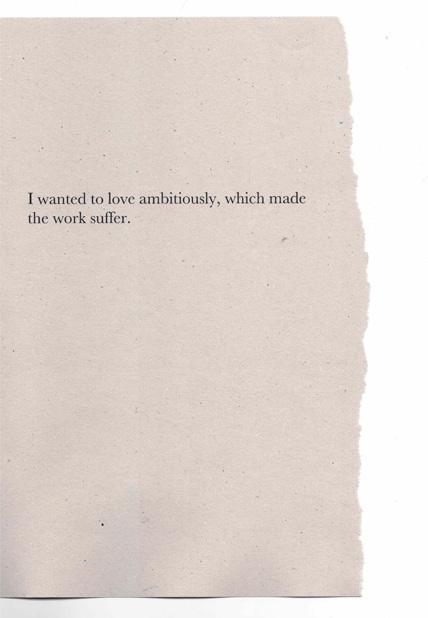
191
190 Untitled Inkjet print on sugar paper • 15x20.5cm
Memoir Screen-print • 56x76cm
Alice Hill-Woods
alicehillwoods@gmail.com @alice35mm
In the spring and autumn of 2022, Art Writing led two masterclasses which invited participants to consider how biomythography, or biographical fiction-ing and related approaches, allows for generative, radically subjective narratives in response to ‘real’ or ‘factual’ historical and contemporary events in their own lives and the lives of others (both real and imagined). It was proposed that such approaches allow writers to control the extent and manner of self-exposure and negotiate complex ethical considerations through the adoption of the guises, slippages, diversions and decoys characteristic of quasi-biography.
Our first session invited Kate Briggs, Alice Hill-Woods, Paul Mendez, Stephen Sutcliffe, Susannah Thompson, and a group of artists and writers at various stages of their career to consider how biography is narrativised, how historical and/or subjective experience is accounted/accountable, what it means to stage a process, to repeat something, to copy out or appropriate, and, ultimately, examining the threshold between a tale and a life. Focusing on creative approaches to biographical, memoir, and life-writing our first workshop drew on alternative modes of biographical writing including autofiction, mythobiography,
New Narrative, fictocriticism and epistolary or diaristic forms of art writing. Our second session looked to genre, form, register, in particular, the materialisation of the lyric. We were joined by artists and writers including Claire-Louise Bennett, Nicky Coutts, Laurence Figgis, Michael Pedersen, and Margaret Salmon. Looking to the forms of attachment, homage and preservation present in the impulse or desire of writing with or about others, we asked how profound knowing might require the affective, creative, and vernacular dimension of the lyric.
193 192
Masterclass Biographical Fictioning
Graphics and Illustrations by Kate Timney.
Friday Events
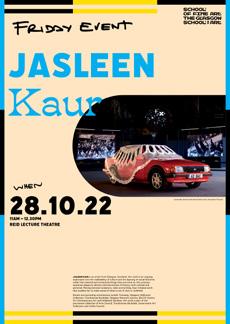







Programme Information
The School of Fine Art (SoFA) offers a suite of one-year Master of Letters (MLitt) programmes: Fine Art Practice (with three disciplinary pathways), Curatorial Practice (Contemporary Art), and Art Writing. Each programme presents final stage Masters Project work in August, showcasing in SoFA’s Stow Building, across numerous satellite venues, and online as part of The Glasgow School of Art’s Digital Showcase.
The Postgraduate Degree Show 2023, showing 24–31 August 2023, is presented across four floors of Stow: Fine Art Practice showing on Level G-1, and Curatorial Practice & Art Writing exhibiting on Level 3.
Postgraduate Degree Show 2023
25–31 August, Stow Building, G4 9LL
Preview: 6–8pm 24th August
Fine Art Practice
This programme consists of three combined studio-based disciplinary pathways: Painting, Drawing & Print Media, Photography & the Moving Image, and Sculpture & Performance. Each pathway offers students the opportunity to immerse themselves within research and studio practice while engaging in cross and interdisciplinary theoretical and methodological dialogue.
@gsafineartpractice
Curatorial Practice (Contemporary Art)
Established in 2014, the Curatorial Practice programme is jointly run by The Glasgow School of Art and the University of Glasgow and offers students the opportunity to study curatorial practice in Glasgow, a city with a vibrant and distinctive international art scene. Throughout the year students are supported to identify and undertake individually motivated curatorial projects and research as the basis for the development of a self-sustaining practice, making this programme distinctive in its delivery.
@glacuratorial Art Writing
This interdisciplinary, studio-based, writing programme offers students the opportunity to develop expansive and innovative modes of writing about, with and as art. With an emphasis on reflexive and critical practiceled enquiry, the programme reflects the development of alternative forms of critical and theoretical writing and expanded relationships between writing and artistic practice. The programme offers full and part-time pathways, with a masters award gained after one or two years and publishes
The Yellow Paper: Journal for Art Writing annually in print and online at theyellowpaper.org.uk
@artwritingGSofA
@_theyellowpaper
197
196
MLitt Fine Art Practice
would like to thank
Staff
Mick McGraw
Dr Marita Fraser
Michelle Hannah
Dr Jane Topping
Administrator
Louise Kerr
Visiting Lecturers
Sara Barker
Jamie Crewe
Kate Davis
Erica Eyres
Cicely Farrer
Michael Fullerton
Onyeka Igwe
Sekai Machache
Lorna Macintyre
Owain McGilvary
Stuart MacKenzie
Dr Clare Stephenson
Agnieszka Szczotka
Hock Aun Teh
Dr Sharon Young
MLitt Curatorial Practice (Contemporary Art) would like to thank
Staff
Dr Karen Di Franco
Dr Alexandra Ross
Administrator
Silas Lehane
Visiting Specialists
Yvonne Billimore
Jenny Brownrigg
Katrina Brown
Dr Helen Charman
Prof. Sarah Cook
Ashanti Harris
Jessica Higgins
Lydia Honeybone
Dr Marcus Jack
Eliel Jones
Mason Leaver-Yap
Dominic Paterson
Thom Rees
Chloe Reith
Dr Tawnya Selene Renelle
Dr Irene Revell
MLitt Art Writing would like to thank
Staff
Dr Laura Haynes
Administrator Silas Lehane
Tutors, Visiting Lecturers, Guests and Hosts
Lauren Dyer Amazeen, Claire-Louise Bennett, Dr Daniela Cascella, Esther Draycott, Laurence Figgis, Dr Laura Guy, Dr Colin Herd, Jess Higgins, Maria Howard, Eliel Jones, Neil McGuire, Michael Pedersen, Edwin Pickstone, Dr Tawnya Selene Renelle, Margaret Salmon, Stephen Sutcliffe, Prof. Susannah Thompson
Special thanks to all the Art Writing students, to Lauren Dyer Amazeen, The Alasdair Gray Archive, Mitchell Library & Archives, Claire-Louise Bennett, Kate Briggs, CAConrad, Daniela Cascella, Cove Park International Residency Centre, Duncan Chappell, The Poetry Club, GSA Archive & Collections, Sorcha Dallas, Brian Dillon, Esther Draycott, Move to Feel, Laurence Figgis, CCA Glasgow, Laura Guy, Annie Hazelwood, Colin Herd, Jessica Higgins, Alexia Holt, Maria Howard, Eliel Jones, Mason Leaver-Yap, Silas Lehane, Glasgow Women's Library, Jen Martin, Anne-Marie McCann, Conor McGrady, Neil McGuire, Francis McKee, Jeremy Millar, Dominic Paterson, Michael Pedersen, Edwin Pickstone, Good Press, Tawnya Selene Renelle, Margaret Salmon, Sunday's Print Service, GSA Library Services, Stephen Sutcliffe and Susannah Thompson.
The School of Fine Art would like to thank
The Technical Staff; Alan Williams, John Ayers, Stephen Jackson, Sarah L. Smith, Chantal Balmer, Chris Barrowman, Jack Bishop, Sean Black, Paul Boyle, Fraser Brownlee, Andy Burke, Nick Carlin, Jack Cheetham, Scott Crawford, Dylan Esposito, Esther Gamsu, Annie Graham, Jamie Green, Amy Grogan, Karena Hansen, Helen Kalmijn, Giulia Lazzaro, Russell Lamb, Ian MacFadyen, Allison Mackenzie, Lynsey MacKenzie, Danny Main, Linsey McAulay, Aoife McGarrigle, Gayle McGhee, Owain McGilvary, Hannah McInally, Brian, Mcintyre, Dan Miller, Bronagh Murray, Joe O'Brien, Libby Odai, Alys Owen, Kevin Pollock, Alan Roachead, Frances Scott, Katy Scott, Heather Shields, Michael Skeen, Aaron Smyth, Kate Theodore, Georgia Thornton, Harald Turek, Hugh Watt
Thank you to Professor Rebecca Fortnum, Dr Roddy Hunter, Dr Marianne Greated, Professor Sarah Bennett, Janice Hamilton, Julia Malle, Anne-Marie McCann, Kirsty Ogg, Conor McGrady
Thank you to our Professional Practice guests: Dr Felicity Allen, Kate Holford, Dr Anthony Schrag, Jamie Crewe, Katie Bruce, Helen De Main, Dr Tawnya Selene Renelle, Lesley Black, Dr Libby Anson, Xiaoyi Nie, Dr Laura Guy.
Thanks 199 198
Degree Show
Catalogue 2023
MLitt Fine Art Practice
MLitt Curatorial Practice (Contemporary Art)

MLitt Art Writing
School of Fine Art Degree Show Catalogue 2023
Published to coincide with The Glasgow School of Art
Degree Show 24–31 August
Published and distributed by The Glasgow School of Art
167 Renfrew St, Glasgow G3 6RQ
All rights reserved. No part of this publication can be reproduced, copied or transmitted unless written permission is obtained from the publishers or in accordance with the Copyright Design and Patents Act 1988.
Designed by Neil McGuire / After the News
Coordinated and edited by Marita Fraser
Printed by Thomsons jtcp.co.uk
Special thanks to:
All teaching, technical, support and visiting staff, as well as the student representative council (SRC)
gsa.ac.uk
Image courtesy of Michelle Hannah from the exhibition 'Title…Pending', performance by Ellen Crofton


 Image courtesy of Michelle Hannah from the exhibition 'Title…Pending', performance by Ellen Crofton
Image courtesy of Michelle Hannah from the exhibition 'Title…Pending', performance by Ellen Crofton








 Mick
Mick








































































































































